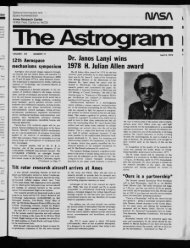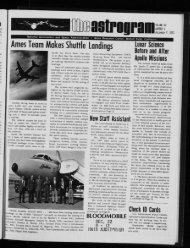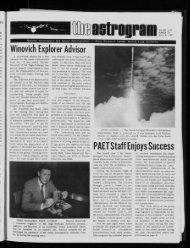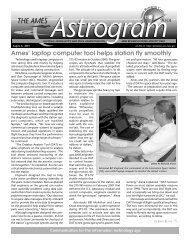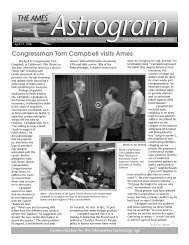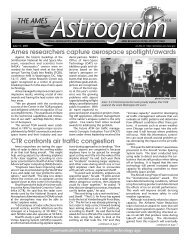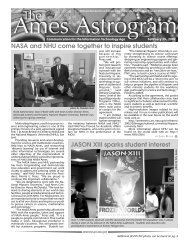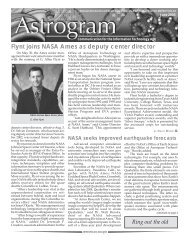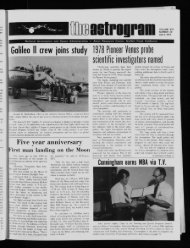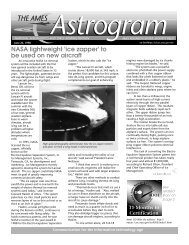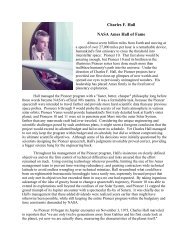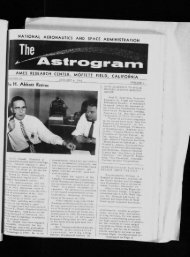Innovative partnership to revolutionize NASA supercomputing
Innovative partnership to revolutionize NASA supercomputing
Innovative partnership to revolutionize NASA supercomputing
You also want an ePaper? Increase the reach of your titles
YUMPU automatically turns print PDFs into web optimized ePapers that Google loves.
Young minds design for living in space<br />
Going <strong>to</strong> space has been an adventure<br />
only a select few have experienced,<br />
but students from around the world are<br />
dreaming of ways <strong>to</strong> change this.<br />
Seeking <strong>to</strong> harness this creative energy,<br />
<strong>NASA</strong> developed the annual Space<br />
Settlement Design Contest.<br />
The contest builds upon the students'<br />
fascination with space and explo-<br />
ration by challenging them <strong>to</strong> develop a<br />
permanent orbital space colony that is<br />
fully enclosed and self-sustaining. Students<br />
must account for the colony's basics:<br />
design, resource management, environmental<br />
controls, transportation,<br />
but also the inhabitants’ recreational<br />
needs.<br />
In 2004, the contest received 122<br />
submissions from 444 students sponsored<br />
by 29 teachers. Entries came from<br />
Germany, India, Japan, Malaysia, Pakistan,<br />
Romania and the United States,<br />
California, Colorado, Florida, Illinois,<br />
Missouri, New Hampshire, New<br />
Mexico, New York, Tennessee and Virginia.<br />
The contest has grown considerably<br />
since its inception<br />
in 1984.<br />
"The contest<br />
is designed <strong>to</strong><br />
spark a student's<br />
interest in math<br />
and science and<br />
<strong>to</strong> develop the<br />
ideas and skills<br />
that will make orbital<br />
colonies a<br />
possibility," said<br />
Al Globus, <strong>NASA</strong><br />
scientist and a<br />
founding member<br />
of the contest.<br />
Students in<br />
grades six <strong>to</strong> 12can<br />
enter in<strong>to</strong> the<br />
individual, team or large group categories<br />
with the best of the category winners<br />
chosen as the grand prizewinner.<br />
This year, the grand prizewinners<br />
were Flaviu Valentin Barsan, Andrei Dan<br />
Costea and Carmen Maria Sigovan from<br />
Constantza, Romania with their entry<br />
'LEDA.' The three are high school stu-<br />
Hubbard presented with robotics award<br />
From left <strong>to</strong> right: Dennis Cunningham, Karen Petraska, Steve Kyramarios, Alan Federman, Mark<br />
Leon and Edwin Sabathia present Ames Center Direc<strong>to</strong>r G. Scott Hubbard with the FIRST Robotics<br />
Competition Chairman’s Award. Hubbard said that the success of programs like <strong>NASA</strong>'s Robotics<br />
Education Project will ensure that the United States produces the required advanced degrees in<br />
robotics engineering. "Winning the Chairman's Award is the greatest honor that any team in the<br />
FIRST Robotics Competition could hope <strong>to</strong> get. It's taken us six years <strong>to</strong> achieve it," said Mark Leon,<br />
education deputy chief. “The Chairman's Award is our team's greatest achievement. It recognizes<br />
the efforts of our men<strong>to</strong>rs and students <strong>to</strong> build our once smallest team in the nation in<strong>to</strong> a team<br />
that is able <strong>to</strong> give back <strong>to</strong> the community," stated Chris Ishisoko, team president and current Ames<br />
intern.<br />
dents men<strong>to</strong>red by Ion Bararu.<br />
“The goals of <strong>NASA</strong>'s Space Settlement<br />
Design Contest are <strong>to</strong> spark a students<br />
interest in math, science and spacerelated<br />
disciplines as well as <strong>to</strong> inspire<br />
the next generation of explorers. This<br />
year's grand prize winners were particularly<br />
impressive in this pursuit.<br />
Barsan, Costea and Sigovan enthusiastically<br />
presented their design entitled<br />
'LEDA' <strong>to</strong> the assembled group of scientists,<br />
parents, students and instruc<strong>to</strong>rs<br />
in the Mars Theater in June. Their detailed<br />
Power Point presentation was well<br />
received by the entire group including<br />
members of the local media. The students<br />
were accompanied by their instruc<strong>to</strong>r,<br />
Bararu, who should be commended<br />
for motivating and inspiring<br />
his students in this international contest,”<br />
stated Bryan Yager.<br />
As part of the contest, the winners<br />
are invited <strong>to</strong> <strong>NASA</strong> Ames <strong>to</strong> <strong>to</strong>ur the<br />
center and meet the <strong>NASA</strong> experts. In<br />
June, the grand prizewinners and 12<br />
other prize-winning students, from as<br />
far away as Romania and India, visited<br />
Ames.<br />
During the visit, contest winners<br />
started the day at the <strong>NASA</strong> Exploration<br />
Center and were greeted by the contest's<br />
organizers and were given presentations<br />
by some of <strong>NASA</strong>'s leading scientists in<br />
the field of life sciences. Team LEDA<br />
then presented their winning concept<br />
for an orbital space colony followed by<br />
a presentation by another Romania team,<br />
SEEDS. After a presentation about Mars<br />
and lunch, the winners visited several<br />
Ames facilities including the 20-G centrifuge,<br />
FutureFlight Central,<br />
the Hyperwall and the NAS<br />
<strong>supercomputing</strong> facility.<br />
The <strong>NASA</strong> Space Settlement Design<br />
Contest is administered by the Fundamental<br />
Space Biology program<br />
funded by <strong>NASA</strong>’s Office of Biological<br />
and Physical Research, investigates fundamental<br />
biological processes through<br />
space flight and ground-based research.<br />
Bringing <strong>to</strong>gether state-of-the-art science<br />
and technology, the program seeks <strong>to</strong><br />
answer the most basic questions regarding<br />
the evolution, development and<br />
function of living systems.<br />
To view the winning submissions<br />
and more information about the Space<br />
Settlement Design Contest, visit: http:/<br />
/www.nas.nasa.gov/About/Education/SpaceSettlement/Contest/<br />
For information<br />
on the Fundamental Space<br />
Biology program visit: http://<br />
fundamentalbiology.arc.nasa.gov/ For<br />
information on <strong>NASA</strong>’s Office of Biological<br />
and Physical Research visit http:/<br />
/spaceresearch.nasa.gov/<br />
BY JONAS DINO<br />
Astrogram<br />
8<br />
August 2004<br />
<strong>NASA</strong> pho<strong>to</strong> by Dominic Hart



